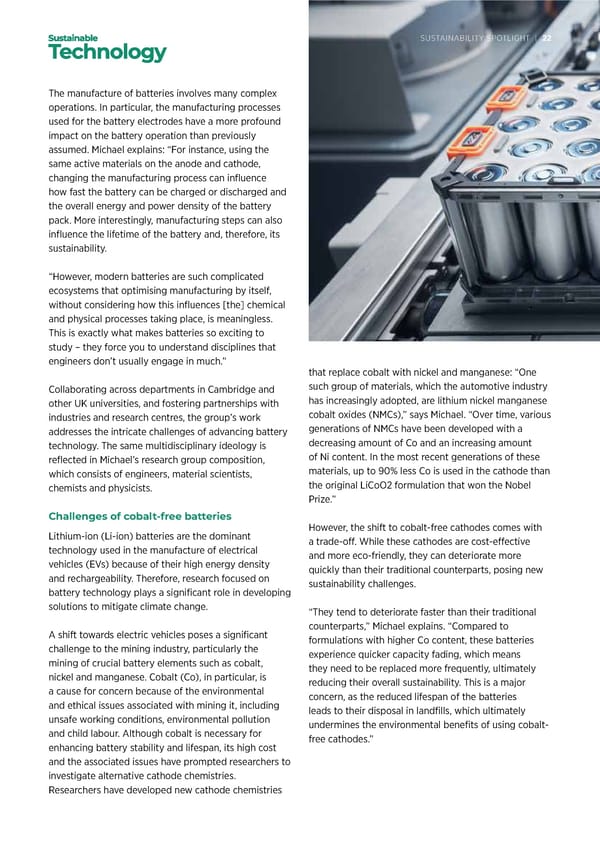SUSTAINABILITY SPOTLIGHT | 22 SUSTAINABILITY SPOTLIGHT | 23 The manufacture of batteries involves many complex operations. In particular, the manufacturing processes used for the battery electrodes have a more profound impact on the battery operation than previously assumed. Michael explains: “For instance, using the same active materials on the anode and cathode, changing the manufacturing process can influence how fast the battery can be charged or discharged and the overall energy and power density of the battery pack. More interestingly, manufacturing steps can also influence the lifetime of the battery and, therefore, its sustainability. “However, modern batteries are such complicated ecosystems that optimising manufacturing by itself, without considering how this influences [the] chemical and physical processes taking place, is meaningless. This is exactly what makes batteries so exciting to study – they force you to understand disciplines that engineers don’t usually engage in much.” that replace cobalt with nickel and manganese: “One While the EV industry is gradually embracing cathodes “As part of another grant, we are looking at how Collaborating across departments in Cambridge and such group of materials, which the automotive industry with lower Co content, according to Michael, either manufacturing processes a ect the lifetime of these other UK universities, and fostering partnerships with has increasingly adopted, are lithium nickel manganese the latest versions are not in use or their capacity is batteries. This work is sponsored by a £2 million ERC industries and research centres, the group’s work cobalt oxides (NMCs),” says Michael. “Over time, various intentionally limited to slow down the degradation Consolidator Grant, on which I am the PI. This grant addresses the intricate challenges of advancing battery generations of NMCs have been developed with a process because of stability concerns. looks specifically at the development of scalable technology. The same multidisciplinary ideology is decreasing amount of Co and an increasing amount continuous processes for manufacturing better battery reflected in Michael’s research group composition, of Ni content. In the most recent generations of these Balancing act: low-cobalt cathodes electrodes and bridging the so-called Valley of Death which consists of engineers, material scientists, materials, up to 90% less Co is used in the cathode than Given these challenges, the mission is to reduce cobalt between academic research and industry. These new chemists and physicists. the original LiCoO2 formulation that won the Nobel content without compromising battery longevity. manufacturing processes impact not only battery Prize.” In the spirit of multidisciplinary research, the IfM’s lifetime but also their energy and power density,” says Challenges of cobalt-free batteries Nanomanufacturing Group is working on a number of Michael. However, the shift to cobalt-free cathodes comes with di erent projects with partners from around the UK. Lithium-ion (Li-ion) batteries are the dominant a trade-o . While these cathodes are cost-e ective Finally, Michael’s group is part of a £14 million multi- technology used in the manufacture of electrical and more eco-friendly, they can deteriorate more university Faraday Institution grant headed by the vehicles (EVs) because of their high energy density The most significant project related to this research quickly than their traditional counterparts, posing new topic is a multi-university £22 million grant from the University of She eld on the development of next- and rechargeability. Therefore, research focused on sustainability challenges. generation batteries that are entirely cobalt-free. battery technology plays a significant role in developing Faraday Institution, headed by Professor Clare Grey in the Department of Chemistry. Michael leads one The group is focused on developing and optimising solutions to mitigate climate change. “They tend to deteriorate faster than their traditional manufacturing steps to suit these new material of the three project work packages, working with counterparts,” Michael explains. “Compared to colleagues from the University of Warwick, Imperial chemistries and aligning their performance more closely A shift towards electric vehicles poses a significant formulations with higher Co content, these batteries with the requirements for their commercial adoption. challenge to the mining industry, particularly the College London, Newcastle University, University experience quicker capacity fading, which means College London, the University of Birmingham, the mining of crucial battery elements such as cobalt, they need to be replaced more frequently, ultimately The group’s research findings will contribute to the nickel and manganese. Cobalt (Co), in particular, is University of Oxford, the University of She eld and reducing their overall sustainability. This is a major the University of Southampton. He explains: “We are manufacture of batteries to help mitigate climate a cause for concern because of the environmental concern, as the reduced lifespan of the batteries change without creating new environmental challenges and ethical issues associated with mining it, including looking at degradation processes that are a result of leads to their disposal in landfills, which ultimately incompatibilities between classic electrolytes and new by relying on unsustainable materials. Michael is unsafe working conditions, environmental pollution undermines the environmental benefits of using cobalt- optimistic that the landscape holds significant promise. and child labour. Although cobalt is necessary for cathodes with very low cobalt content. The team is free cathodes.” looking at developing better cathodes and the anodes “The journey towards cobalt-free batteries aligns enhancing battery stability and lifespan, its high cost with the commitment to combat climate change and and the associated issues have prompted researchers to of batteries. underscores the pivotal role of advanced manufacturing investigate alternative cathode chemistries. in shaping a cleaner and more energy-e cient Researchers have developed new cathode chemistries landscape.”
 Sustainability Spotlight Magazine Page 21 Page 23
Sustainability Spotlight Magazine Page 21 Page 23